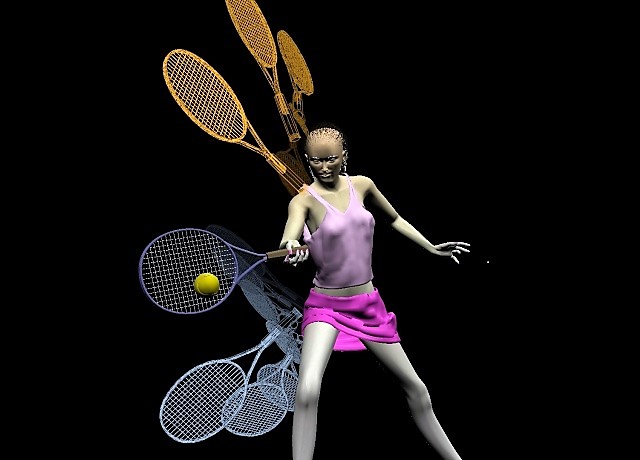Producing Spin
!!HERESY ALERT!! --- The following runs contrary to everything that has been taught by tennis pros for the last 40 years. Some will recognize it as fact immediately - others will reject it out of hand as being contrary to "established science." While I understand this impulse, I strongly suggest you read this section very carefully and try this technique as I believe it is an essential component of A-level tennis.
In the days of yore when Rod Laver's topspin forehand was the most powerful shot in tennis, the general understanding of just how he managed to develop such wicked topspin on the ball was that he used his monstrous, lobsteroid left arm to "roll over the top of the ball" thereby imparting spin. Many of us tried to replicate that famous stroke, but most of us found ourselves driving the ball repeatedly into the base of the net. Some smart teaching pro noticed that successful practitioners of this art also typically started the racket's forward motion from a point well below the ball and finished well above the ball. They surmised that the apparent "rolling over the ball" was an illusion, and that the actual physics involved was friction up the back of the ball causing a torque on the ball that we know occurs whenever a racket is moving in one direction and pointing in another (See Figure below if that is unclear). The application of this technique to producing topspin was called "brushing up the back of the ball" and in those days the brushing technique was applied every time one wanted to add spin to a tennis ball. The brushing action seemed to correlate pretty well with appropriate grip selection; the western and semi-western forehand grips seemed to enhance topspin production, and we attributed the improved spin to having the hand more under the racket to achieve more upward racket head speed. The continental grip seemed a natural for applying underspin to groundstrokes and topspin and sidespin to the serve because the hand was on top of the racket. The physics seemed sound and many talented players who learned and practiced this technique (like Bjorn Borg) developed serviceable topspin groundstrokes, at least as long as rackets were made of wood. The topspin backhand was still a bit of a problem even for the most talented people on the planet but, heck, one could always resort to the two-handed backhand which put plenty of top on the ball, so no one worried about the one-handed topspin backhand.
As rackets improved allowing everyone to hit with more and more pace, the brush technique for adding spin proved to be problematic. Achieving topspin by brushing up the back of the ball is the natural enemy of pace. The greater the angle of attack, the more spin but less pace you get on the ball. Control was also an issue. When our groundstrokes would start missing the baseline, we would accentuate the upward brushing motion in an attempt to get more topspin, but dragging up on the ball drags it up and out of play. (see Push Syndrome). We try to compensate by tipping the racket face down a little, so it is actually pointing at the base of the net when we make contact with the ball, and that seems to work...sometimes. Its a rather delicate dance though - drag up for topspin, point down to counter the dragging up. Just another one of those magical things that only very talented people can do consistently, or so I thought.

